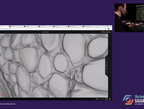Nira - Interactively review, organize, and collaborate on 2D/3D production assets
Interactively review, organize, and collaborate on 2D/3D art and design assets across your entire pipeline. Any filesize, any renderer, any browser, any device, anywhere. ...learn more
Project status: Published/In Market
Virtual Reality, oneAPI, Mobile, Networking, Game Development, Graphics and Media, Cloud
Intel Technologies
oneAPI,
Intel CPU,
Other,
SVT (video encoders)
Overview / Usage
Nira is an art and design management tool that allows interactive review, organization, and collaboration on large 2D/3D assets across an entire pipeline using a web browser on any device. Nira is useful for Media & Entertainment, Product Design, Engineering, and any other segment that has cause to view, inspect, iterate on, and organize 3D and 2D digital assets.
Features:
Powerful Viewer
Instantly load and view digital assets of any size using any device -- including mobile devices.
Many human-hours are lost on waiting for digital asset files to load, so we gave special attention to minimizing load times: Sub-second for tens of millions of triangles, seconds for hundreds of millions of triangles, and tens of seconds for billions of triangles. Full navigation interactivity is maintained even for assets that are billions of triangles in size.
Inspect & Review
Swiftly identifying issues is paramount during production of digital assets. Nira provides a toolset to quickly find and resolve a variety of different asset issues with intuitive scene debugging and camera navigation using mouse, keyboard, touch, or AR.
When reviewing assets for correctness, design and engineering project stakeholders need a tool they can count on to match the source data, so with Nira, special attention was given to the ability to produce images that are representative of the underlying data. Triangle decimation, vertex position quantization, LOD streaming, and other techniques commonly employed by client-based renderers were avoided.
In production pipelines, a myriad of different renderers with differing feature sets are used to produce imagery: Unity, Arnold, Unreal, V-Ray, Blender Cycles, and many more. Nira supports multiple renderers, so stakeholders can visualize assets using whatever engines they use in their pipeline, giving them the ability to perform reviews and visualizations that match their real-world results.
By integrating with the latest renderers, Nira can also quickly take advantage of the latest hardware and software advancements. A great example of this is our integration with the Intel® OSPRay Renderer, which efficiently uses threading and vectorization to create interactive, high-fidelity applications on CPUs from Intel.
Collaborate & Track
In many design or engineering pipelines, asset change requests are strewn across a disorganized hodge-podge of different methods (email, screenshots, slack, dropbox), which often leads to miscommunications and countless hours of work being thrown out and redone. With Nira, a centralized, unified, collaborative, and multi-platform set of visual markup tools allow stakeholders of any experience level to provide and organize precise feedback on all iterations.
Share & Organize
Send links, not data. Nira allows assets to be shared using a simple web link. There's no need to understand complex controls, learn a new DCC, or wait for huge files to download.
Methodology / Approach
To achieve quick loading and interactive viewing production art/design/engineering assets, Nira employs: a custom server-side asset ingestion pipeline, a custom server-side real time rasterization renderer tuned for interactivity on large assets and specialized visualization modes for inspection/validation of various asset metadata, a collection of intuitive markup and review tools, and existing hardware video encode/decode capabilities of both server-side and client-side devices. Assets are provided to Nira via web drag-drop or via an API; The API allows organizations to integrate Nira into their existing asset pipelines and asset management tools.
In addition to Nira's own rasterization-based real time renderer, it also integrates with other production renderers, notably the Intel® OSPRay Renderer: A cluster-capable, scalable, extendable, ray-tracing, rendering toolkit that includes path tracing and volume rendering. It efficiently uses threading and vectorization to create interactive, high-fidelity applications on CPUs from Intel. OSPRay is part of the Intel oneAPI Rendering Toolkit and is released under the permissive Apache 2.0 license.
Technologies Used
Intel® OSPRay and Intel® Embree (both components of the Intel oneAPI Rendering Toolkit). These utilize recent Xeon processors with the latest vector extensions (AVX512).
Xeon 3275 (28 core 56 thread) 2.5 Base, 4.4 Turbo (Huge Thanks to BOXX Technologies for providing the hardware for our Siggraph Demo and others)
Nira's asset ingestion tools use multi-threading (via Intel® TBB, and OpenMP) and SIMD (via SSE intrinsics) to accelerate asset processing times.
Hardware Accelerated Video Encoding: For low-latency encode of H264 video, we're currently utilizing ASIC-based encoders on popular GPU models.
TBD:
Optane would be interesting to explore for even further accelerating asset load times.
Other links
-
 Our Siggraph 2019 Real-Time Live presentation (starts @ 55:48, 7min duration)
Our Siggraph 2019 Real-Time Live presentation (starts @ 55:48, 7min duration)
- Nira Website
- Interactively navigating the Moana Scene using Nira's Intel OSPRay integration
Collaborators
There are no people to show.






